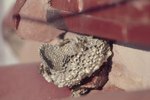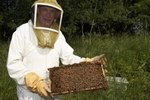
The Philippine islands are home to four indigenous species of honey bees and one imported species. Harvesting honey is not only a mainstay for smaller villages, but in larger areas beekeeping is a growing industry. Certain honey bees provide more than a sweet treat. The natural resins from their combs have cosmetic and medical benefits.
Dwarf Honey Bee
Ants are a natural predator of honey bees, and dwarf honey bees protect their nests from ants by coating both ends with propolis, a sticky resin made from botanical sources. They hide their nests in foliage, and worker bees layer themselves three to four deep to cover the comb. If disturbed, workers take off in unison to swarm the intruder. The upper part of the comb contains the honey, and locals harvest it by cutting away the top. If the bees don’t abandon the nest and repair the damage, locals wait six to eight weeks to harvest again.
Giant Honey Bee
Unlike their dwarf cousins, the larger size of giant honey bees is usually enough to protect them from ant invasions. They build their nests in the open, and when 10 or more nests are in a tree, it's referred to as a “bee tree.” Like their cousins, their honey is mainly hunted, and it brings high prices at local markets. Although their prized honey is sweet, they are extremely aggressive. When disturbed, swarms of defenders have been known to follow an intruder for more than 100 yards.
Eastern Honey Bee
Eastern honey bees, also known as oriental honey bees, have provided humans across the globe with honey and beeswax for centuries. For beekeepers, the open-air nesting of dwarf and giant honey bees makes it difficult for them to survive in man-made enclosures. However, eastern honey bees build their hives in places such as caves and hollowed-out trees. Thriving in darker habitats has allowed beekeepers to raise them in pots and boxes for thousands of years.
European Honey Bee
European honey bees are one of the most common and productive. Their honey is high yielding, and since they prefer darker habitats their large colonies are easy for keepers to maintain. The queen can lay up to a thousand eggs a day, and she controls whether or not the egg is fertilized. Unfertilized eggs will develop as males. Depending on how the larva is fed, a fertilized egg will develop as a male or female worker, or a new queen. In the Philippines, beekeepers imported this species. However, being imported makes them more susceptible to diseases.
Stingless Bee
With funding from the Bureau of Agriculture Research, a bee program at a Philippine University is researching the benefits and profitability of native stingless bees. These bees are not only sustainable and abundant, but their honey is one of the most expensive. Their resins have clinical value due to their anti-fungal or anti-bacterial properties, and locally these resins are used in soaps, shampoos and toothpastes. Stingless bees are the main pollinator of mango trees, and they help pollinate neighboring coconut plantations.
References
Photo Credits
-
Hemera Technologies/Photos.com/Getty Images
Writer Bio
Slone Wayking worked as a professional in the veterinary field for 20 years. Though her interest in animal health led to this path, Wayking initially studied creative arts. She has been article writing for more than a year and is currently working towards her degree in multimedia. Her certifications include business writing and basic web design.




